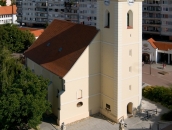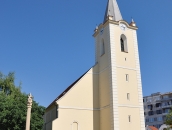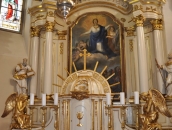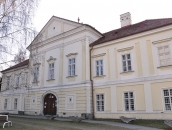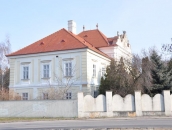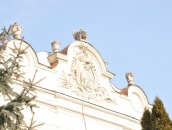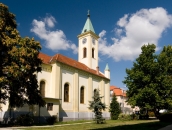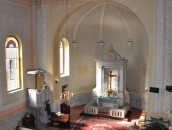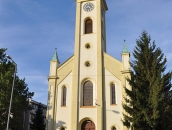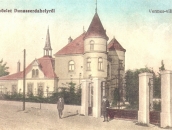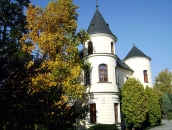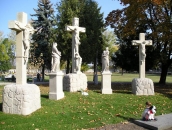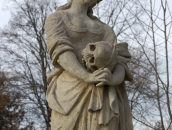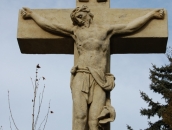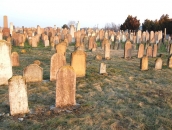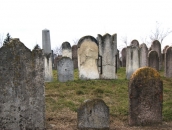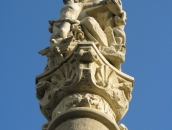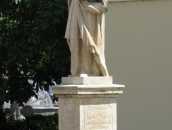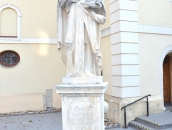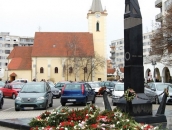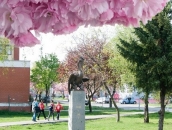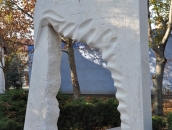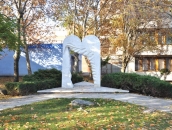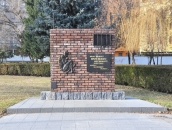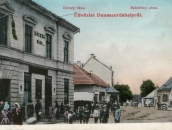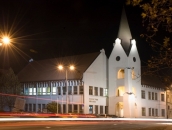According to references from the early Árpád period, a wooden church probably stood on the site of the present Roman Catholic church. The stone foundations of the church, nave, sanctuary and tower were built in 1329 in Gothic style. The church underwent extensive reconstruction works in 1518 being extended by a side nave in late Gothic style and in years 1742-43 in Baroque style when the whole building was renovated, the tower built and the church walls were increased. The Baroque architectural style has been maintained on the church building to this day.
The Baroque 18th-century main altar is decorated with the painting of the Ascension of the Virgin Mary, above it there is a statue of St. George the patron saint on horseback. The side altars dating back to the late Baroque period are decorated with paintings of King Stephen and Pieta. In the family vault in this church lie deposited the mortal remains of one of the best-known families in the city, the Pókateleki Kondé family.
In 1753 on behalf of Padányi Biró Márton, Bishop of Veszprém a two-storey spacious mansion, the later Yellow Mansion was built, to which a large estate belonged, for his brother Biró István in Pókatelek district.
"For our brother István (...) we built in Pókatelek (...) a decent and very spacious residence, adorned from outside with St. Márton (St. Martin) the Bishop and Confessor´s effigy carved in stone and other embellishments and items." - writes the bishop in his will about the building.
After the death of Biró István, the Kondé family from Pókatelek got hold of the valuable manor and its endowments by marriage who reshaped it (the pediment was ornamented with the coat of arms of Kondé family along with the monumental stone turkey statue above) in the beginning of the 19th century according to their own taste. They owned the castle for about sixty years which was for a long time the only two-storey house of the town.
In 1858 Miklós Wahlberg, university professor in Vienna, purched the building from the Kondé family and leased it out. The mansion was inherited by Wahlberg´s daughter and sold by her in 1910 to the Dukesz-Herzog company residing in Hlohovec, who purchased it for economic goals. The Hungarian military administration was housed here in years 1938-1944. In 1944 and 1945 the German, later the Russian military commands arranged their seats here. Shortly thereafter, the Czechoslovak military authorities took over the building. Since 1953, the Land Office resided in the Yellow Mansion until 1972 - when the Rye Island Museum moved here from the Bacsák family’s White Mansion with space granted for permanent exhibitions and expert research. In 1977, the Mansion’s main building was renovated, which in the museum's permanent exhibition halls have been located until present.
The church was built between 1863-1883 in a simplified neo-Romanesque style. The nave has a plain ceiling with an interesting suspension solution and polygonal closure; the tower - which was only built to the church in 1938 - slightly exceeds the plane of the main façade. The marble baptismal font dates from 1883, the organ from 1903, while the neo-classicist main altar was made in Banská Bystrica in 1933.
In the building of the former Talmud Torah in Bacsák Street, there is a house of prayer for faithful of the Jewish religious community. In the past, two synagogues used to be in the city. The orthodox Great Synagogue used to be in the Main Street and the Orthodox Synagogue of Ászád Jiszráel used to stand in Nemesszeg Street; both buildings were demolished after World War II.
The original building of the villa was a one-storey house built in 1905 on behalf of Ferenc Vermes, landowner and supervising judge. It was modernised, enlarged and embellished by towers by its then-owner in 1909 – and the villa received its present form.
During World War II, it housed the German and later the Russian commandership. In the sixties and seventies of the 20th century the villa was used for leisure-time activities for children and youth. In 1988-2002 it hosted the branch office of the Slovak National Gallery. In 2005, the building was purchased by Dunaszerdahely (Dunajská Streda) Municipality and after rebuilding the Modern Hungarian Gallery moved in.
The Calvary hill was built between the urban districts Nemesszeg and Tejed in the 18th century in a form of a truncated cone of 7 m in height and 12 m in diameter, on the top of which this statue group was placed (to its former location) in 1802. In 1959 in the communist era, the Calvary hill was demolished to give way to road construction and the group of statues was first placed around the St. George Church, then exiled to Nagyudvarnok (Malé Dvorníky) and only returned back to Dunaszerdahely (Dunajská Streda) after the Gentle revolution. Today it can be found in the cemetery.
Mestský cintorín na Malodvorníckej ceste vznikol v roku 1953. Jeho významnou súčasťou sú malé sakrálne pamiatky - staré hroby a náhrobné kamene starých dunajskostredských rodín. Nájdete tu torzo náhrobku rodiny Kondé a tiež hroby a náhrobné kamene bývalých dekanov, lekárnikov a významných remeselníkov mesta.
The Orthodox Jewish cemetery, existing since 1740s, is city's oldest cemetery. It is the final resting place of many generations of Jewish families. Several prominent rabbis' tombs can be found among the well-tended graves, including the one of the famous Rabbi Yehuda Assad, which has become a place of pilgrimage.
V období medzi septembrom 1914 a novembrom 1918 sídlil v našom meste Cisársky a kráľovský vojenský zajatecký tábor, v ktorom v blízkosti mesta žilo 30 000 zajatcov. V cintoríne v Malom Blahove bolo pochovaných 1 500 vojenských zajatcov. Dnes cintorín chátra a nie je udržiavaný.
The statue was built from donations of the faithful of the Christian Reformed Church. Is located in a small park opposite the Reformed Church, commemorating the 2000th anniversary of the birth of Christ, the 1000th anniversary of the Hungarian Kingdom, and the 325th anniversary of the liberation of galley slaves. The sculpture is a work of art created by sculptor János Nagy.
The statue symbolises a tribute to the founder of the Hungarian Kingdom St. Stephen, symbolising unity and establishment of the Kingdom of Hungarians. The author is the sculptor György Lipcsey. It was unveiled at the ceremony on 20 August 2004.
Pamätník je darom múzea vo Várpalote. Bol odhalený 1. novembra 2008.
The two-story house built formerly as coffee house and hotel was sold by its owner, hotelier Pleyer Károly to the city administration in 1901. Since 1902 the upper part of the facility served as municipal offices, while the ground floor accommodated a pharmacy. In the building yard city prison and police station was created for the communal police. Later, as the years passed, the two-storey building has been renovated and restored several times; so it was in 1958-59 when the building was extended.
The building was reshaped again: over the entrance a tower was erected as part of the city's image transformation started according to Imre Makovecz in 1995. In no time, the resulting modified "new" City Hall has become a determining building of Dunaszerdahely cityscape and one of its symbols.

